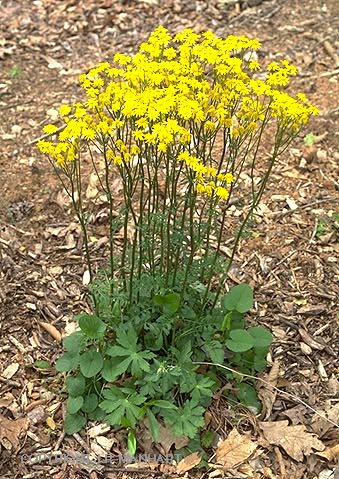Contents:
Common Names | Parts Usually Used | Plant(s) & Culture | Where Found | Medicinal Properties
Legends, Myths and Stories | Uses | Formulas or Dosages | Warning | Bibliography
Scientific Names

- Senecio aureus L.
- Compositae
- Composite family
Common Names
- Cocash weed
- Coughweed
- False valerian
- Female regulator
- Golden ragwort
- Golden senecio
- Grundy swallow
- Life root
- Liferoot plant
- Ragweed
- St. James wort
- Segrum
- Squaw weed
- Staggerwort
- Stammer-wort
- Uncum
- Uncum root
- Waw Weed
Parts Usually Used
Leaves, roots
Back to Top
Description of Plant(s) and Culture
Ragwort is a native perennial plant; the erect, grooved, brown-streaked stem grows from 1-2 feet high and bears alternate, oblong or lanceolate, pinnatifid or lyrate leaves. There are also coarsely toothed basal leaves which are cordate-ovate or reniform, long-petioled and sometimes purplish underneath. Flower heads with golden-yellow rays in flat-topped clusters and brownish disks grow in terminal corymbs from May to July. Highly variable.
Other varieties: Common groundsel (S. vulgaris); European ragwort (S. jacoboea) The two related plants; common groundsel and European ragwort, have similar medicinal properties and are said to affect the liver (not necessarily favorably). Common groundsel is a widespread weed that can be found in gardens, fields, and waste places all over the world.
European ragwort is now a naturalized plant of eastern Canada, the northeastern United States and individual localities elsewhere. The medicinal use of these plants without medical supervision is not advisable.
Back to Top
Where Found
Found in marshes, along stream-banks, swamps, and in other wet areas from Newfoundland to Florida and westward to Wisconsin and Texas.
Back to Top
Medicinal Properties
Diaphoretic, diuretic, emmenagogue, febrifuge, pectoral, tonic
Back to Top
Legends, Myths and Stories
In Sussex, England ragwort is called ragweed.
Back to Top
Uses
Ragwort is used for leukorrhea or suppressed menstruation. Native Americans, early settlers, and herbalists used it to speed childbirth and to induce abortion. Recommended for gravel and other problems of the urinary tract. Useful for rheumatism, sciatica, joint pains, lung ailments, dysentery, diarrhea, dysmenorrhea, lumbago, prostatitis, wounds, bronchial asthma, constipation, ulcers, colic, intestinal problems, blood purifier, high blood pressure, canker sores, chronic sores, coughs, and colds.
Back to Top
Formulas or Dosages
Fluid extract: take 1/2 to 1 tsp. in a cup of water.
Back to Top
Warning
Ragwort contains toxic alkaloids which are known to be poisonous to livestock.
Many ragworts of the Senecio species contain highly toxic pyrrolizidine alkaloids. Care should be exercised to identify Senecio aureus before use and even then medical supervision is warranted. Senecio aureus is distinguished by the heart-shaped leaves at the base of the plant.
Back to Top
Bibliography
![]() American Folk Medicine
American Folk Medicine, by Clarence Meyer, Meyerbooks, publisher, PO Box 427, Glenwood, Illinois 60425, 1973
![]() Back to Eden
Back to Eden, by Jethro Kloss; Back to Eden Publishing Co., Loma Linda, CA 92354, Original copyright 1939, revised edition 1994
![]() Culpeper’s Complete Herbal & English Physician: Updated With 117 Modern Herbs
Culpeper’s Complete Herbal & English Physician: Updated With 117 Modern Herbs, by Nicholas Culpeper, Meyerbooks, publisher, PO Box 427, Glenwood, Illinois 60425, 1990, (reprint of 1814)
![]() Eastern/Central Medicinal Plants
Eastern/Central Medicinal Plants, by Steven Foster and James A. Duke., Houghton Mifflin Company, 215 Park Avenue South, New York, NY 10000
![]() The Herb Book
The Herb Book, by John Lust, Bantam Books, 666 Fifth Avenue, New York, NY. copyright 1974.
![]() Indian Herbalogy of North America
Indian Herbalogy of North America, by Alma R. Hutchens, Shambala Publications, Inc., Horticultural Hall, 300 Massachusetts Avenue, Boston, Massachusetts 02115, 1973
![]() The Herbalist Almanac
The Herbalist Almanac, by Clarence Meyer, Meyerbooks, publisher, PO Box 427, Glenwood, Illinois 60425, copyright 1988, fifth printing, 1994
![]() Webster’s New World Dictionary
Webster’s New World Dictionary, Third College Edition, Victoria Neufeldt, Editor in Chief, New World Dictionaries: A Division of Simon & Schuster, Inc., 15 Columbus Circle, New York, NY 10023
